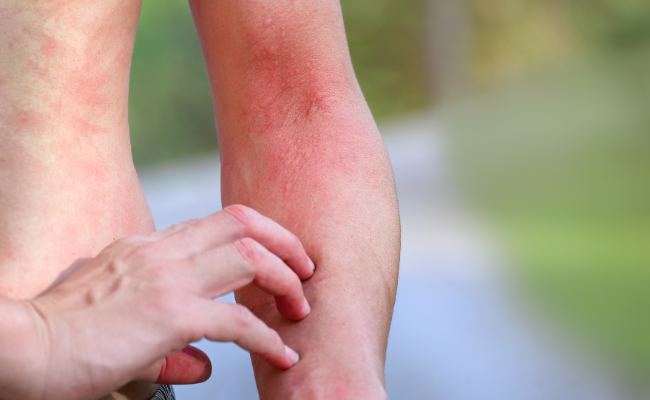How to Treat Dermatomyositis?
- January 04, 2024
- No Comments

What is Dermatomyositis?
Dermatomyositis is a rare autoimmune disorder that uniquely affects both the skin and muscles, falling within the category of idiopathic inflammatory myopathies. This condition is characterized by chronic muscle inflammation, presenting challenges in diagnosis and treatment. Manifesting with distinctive skin rash and muscle weakness, dermatomyositis demands prompt medical attention as it can lead to severe complications, including impairment of breathing and swallowing.
Recognized as an uncommon disease marked by muscle weakness and skin rashes, dermatomyositis, a variant of polymyositis, requires swift intervention. Immediate medical attention is crucial as some cases develop rapidly, and early treatment not only improves the chances of success but also plays a vital role in preventing life-threatening complications associated with this intricate autoimmune disorder, including an increased risk of specific types of cancer.
Why Does Dermatomyositis Occur?
The precise cause of dermatomyositis is not yet fully elucidated, but it is widely believed to result from a combination of genetic, environmental, and immunological factors. The autoimmune hypothesis suggests that the immune system, for reasons not completely understood, mistakenly targets healthy tissues, leading to inflammation in the skin and muscles. There is also evidence supporting a genetic predisposition, as certain individuals may have a higher susceptibility to developing dermatomyositis. Furthermore, environmental triggers, such as infections or exposure to specific drugs, may play a role in initiating or exacerbating the disease.
Understanding the intricate interplay of these factors is crucial for effective management and treatment strategies for dermatomyositis. Researchers continue to explore the underlying mechanisms of the disease to identify potential targets for intervention and prevention.
How is Dermatomyositis Diagnosed?
- The diagnosis of dermatomyositis involves a comprehensive approach that combines clinical evaluation, laboratory tests, and imaging studies. One of the hallmark clinical features is a characteristic skin rash, known as the heliotrope rash, often accompanied by Gottron's papules on the knuckles. These dermatological manifestations, along with muscle weakness, provide important diagnostic clues.
- Laboratory tests play a crucial role in confirming the diagnosis. Elevated levels of muscle enzymes, particularly creatine kinase, are commonly observed in blood tests, indicating muscle inflammation. Electromyography (EMG) and muscle biopsy may be performed to assess the electrical activity and examine muscle tissue under a microscope, respectively. Additionally, imaging studies such as MRI or CT scans may be employed to visualize the extent of muscle involvement.
- The complexity of the diagnostic process highlights the importance of a multidisciplinary approach involving dermatologists, rheumatologists, and neurologists to ensure a comprehensive evaluation and accurate diagnosis.
Treatment Solutions for Dermatomyositis
The management of dermatomyositis necessitates a multifaceted approach aimed at addressing both the skin and muscle components of the disease. Various treatment modalities are employed to alleviate symptoms, reduce inflammation, and improve overall quality of life for affected individuals.
- Corticosteroids: High-dose corticosteroids, such as prednisone, are often the initial treatment to rapidly suppress inflammation. While effective, prolonged use of corticosteroids may lead to significant side effects, emphasizing the need for careful monitoring and dose adjustment.
- Immunosuppressive Drugs: In cases where corticosteroids alone are insufficient or poorly tolerated, immunosuppressive drugs may be introduced. Medications such as methotrexate, azathioprine, or mycophenolate mofetil work by modulating the immune response, reducing inflammation and preventing further damage to muscles and skin.
- Physical Therapy: Muscle weakness and atrophy are common in dermatomyositis, emphasizing the importance of physical therapy. Therapeutic exercises tailored to individual needs can improve muscle strength, flexibility, and overall mobility. Physical therapy also plays a crucial role in preventing complications associated with muscle weakness, such as contractures and loss of function.
- Topical Treatments: Dermatological manifestations, including the heliotrope rash and Gottron's papules, may be managed with topical treatments. These may include corticosteroid creams, calcineurin inhibitors, or other topical agents to alleviate discomfort, reduce inflammation, and improve the appearance of the skin.
- Intravenous Immunoglobulin (IVIG): In cases where conventional treatments are ineffective, intravenous immunoglobulin may be considered. This therapy involves administering high doses of immunoglobulins to modulate the immune system and reduce inflammation. IVIG has shown efficacy in certain cases, particularly when other treatments have failed.
Benefits of Dermatomyositis Treatment
- Symptomatic Relief: Treatment provides symptomatic relief, alleviating muscle weakness, joint pain, and the characteristic skin rash. This contributes significantly to the overall well-being and quality of life for individuals with dermatomyositis.
- Prevention of Complications: Timely intervention and effective treatment help prevent or minimize complications associated with dermatomyositis. Complications, such as difficulty swallowing (dysphagia) or respiratory muscle weakness, can be mitigated with appropriate management.
- Preservation of Muscle Function: Physical therapy and pharmacological interventions play a crucial role in preserving muscle function. These measures prevent muscle atrophy and maintain or improve overall muscle strength, enabling individuals to maintain a higher level of functional independence.
- Improved Skin Health: Topical treatments and systemic medications contribute to the improvement of skin manifestations. This not only reduces physical discomfort but also enhances the aesthetic appearance of the skin, positively impacting the psychological well-being of individuals with dermatomyositis.
- Enhanced Mobility and Independence: The combination of medication and physical therapy aims to enhance mobility, allowing individuals to regain or maintain an active lifestyle. This, in turn, contributes to greater independence and an improved overall sense of well-being.
Comments (0)